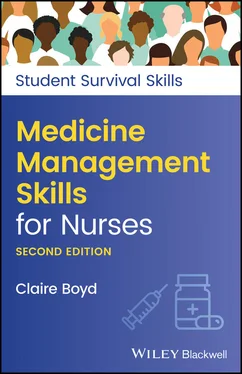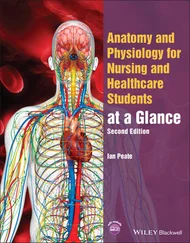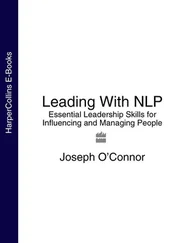Editorial Office 9600 Garsington Road, Oxford, OX4 2DQ, UK
For details of our global editorial offices, customer services, and more information about Wiley products visit us at www.wiley.com.
Wiley also publishes its books in a variety of electronic formats and by print-on-demand. Some content that appears in standard print versions of this book may not be available in other formats.
Limit of Liability/Disclaimer of Warranty The contents of this work are intended to further general scientific research, understanding, and discussion only and are not intended and should not be relied upon as recommending or promoting scientific method, diagnosis, or treatment by physicians for any particular patient. In view of ongoing research, equipment modifications, changes in governmental regulations, and the constant flow of information relating to the use of medicines, equipment, and devices, the reader is urged to review and evaluate the information provided in the package insert or instructions for each medicine, equipment, or device for, among other things, any changes in the instructions or indication of usage and for added warnings and precautions. While the publisher and authors have used their best efforts in preparing this work, they make no representations or warranties with respect to the accuracy or completeness of the contents of this work and specifically disclaim all warranties, including without limitation any implied warranties of merchantability or fitness for a particular purpose. No warranty may be created or extended by sales representatives, written sales materials or promotional statements for this work. The fact that an organization, website, or product is referred to in this work as a citation and/or potential source of further information does not mean that the publisher and authors endorse the information or services the organization, website, or product may provide or recommendations it may make. This work is sold with the understanding that the publisher is not engaged in rendering professional services. The advice and strategies contained herein may not be suitable for your situation. You should consult with a specialist where appropriate. Further, readers should be aware that websites listed in this work may have changed or disappeared between when this work was written and when it is read. Neither the publisher nor authors shall be liable for any loss of profit or any other commercial damages, including but not limited to special, incidental, consequential, or other damages.
Library of Congress Cataloging-in-Publication Data applied for
PB ISBN: 9781119807926
Cover Design: Wiley
Cover Images: © chuwy/Getty Images, © rambo182/Getty Images
This book is designed to assist the student healthcare worker in the field of medicines management. All exercises are related to practice and the healthcare environment. It is full of medicines management information you will need as a healthcare professional.
The book looks at the general principles of drug administration, and features ‘how to’ chapters covering the administration of many types of drug. All the material has been requested by students like you, who told me what they wanted in a medicines management book. It is designed to be a quick reference, one on which you can build your knowledge and skills.
At the start of your nursing career you will observe drug administration and then gradually take a more active part in the process. Don't shy away from this, as one day you will be on your own and the patient will rely on you as being the fount of all knowledge.
Nobody expects you to be all knowing at the start of your career and you will need to have quite a few drug‐related competencies signed off to prove your ability during your training. Many clinical areas also supply students with an induction pack during placement. This pack usually has a section on commonly prescribed medications used in that area. It is from this that you will build up your knowledge of cardiac drugs, renal drugs, drugs used in neurosurgical wards, drugs used in paediatric care, and so on.
The book talks about patients but often uses the community terminology of service user as well. The paediatric nurse has not been forgotten, with information throughout incorporating this branch of nursing.
The book incorporates many exercises to check understanding, to help you to build confidence and competence. It has been also compiled using quotes and tips from student nurses themselves: a book by students for students.
Claire Boyd
Bristol
Hello all, my name is Claire and I have been a nurse and Practice Development Trainer in a large Nation Health Service (NHS) trust for over 30 years (I started very young)! This is the second edition of this book which is jam‐packed with information – filled to the rafters with information in a book small enough to be carried around and referred to without weighing a ton and giving you a hernia!
Chatting to nursing staff, just like you, I have often been told that they have real fears about all aspects of medicines management. These fears are especially with regard to the administration of drugs, knowing that this is a skill they will have to acquire and use throughout their chosen career. Does this sound like you? Are you a little over‐awed with the prospect of being let loose in your clinical area to administer drugs to the patients?
To add to the fear factor, many students complain that they are often unable to practice their drug‐administration competences under supervision due to the ever‐increasing demands on the preceptor (wait until you become one and see how hard it is!). They tell me that they are not getting adequate input in the area of medicines management during their training, so their thinking is, ‘how am I meant to get my competences signed off, let alone become confident and competent?’
No need to fear: this book will at least give you the knowledge behind the skill, increasing your confidence and competence prior to really getting stuck in with the ‘hands‐on’ element in your clinical area. In short, this book is designed to support you, the Student Nurseas well as those who are newly qualified – the Newly Qualified Nurse(NQN) – congratulations on your wonderful achievement. Also, with the ever‐changing face of health care, it is also aimed at those of you who are now expected to administer medications, namely the Assistant Practitionersand to the newer members of our family the Nursing Associateand the Non‐Medical Nurse Prescriber(NMP). This book is also for those of you coming back into nursing – The Return to Practice Nurseand Overseas Nurses– welcome all!
This book contains the information and exercises I deliver to healthcare professionals during their medicines management training. I hope that I have made the writing style informal but brief, as though I am sitting beside you to help you along the way. All the answers to the activities, questions, and ‘Test your Knowledge’ exercises can be found at the back of the book.
Remembering my own time as a student nurse, it was being let loose with the drug trolley that most scared me: what if I made a mistake? Times have not changed, as many of you have informed me that you need a book to increase your theoretical knowledge, as well as to advise on the practicalities.
Throughout the book students have added their own words of wisdom, in the form of tips for their peers from their own experiences, or queries they may have had. I have also taken on board subjects you wanted added to this second edition:
Web resources added to chapters – tick
Читать дальше












